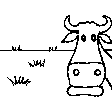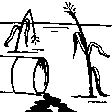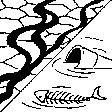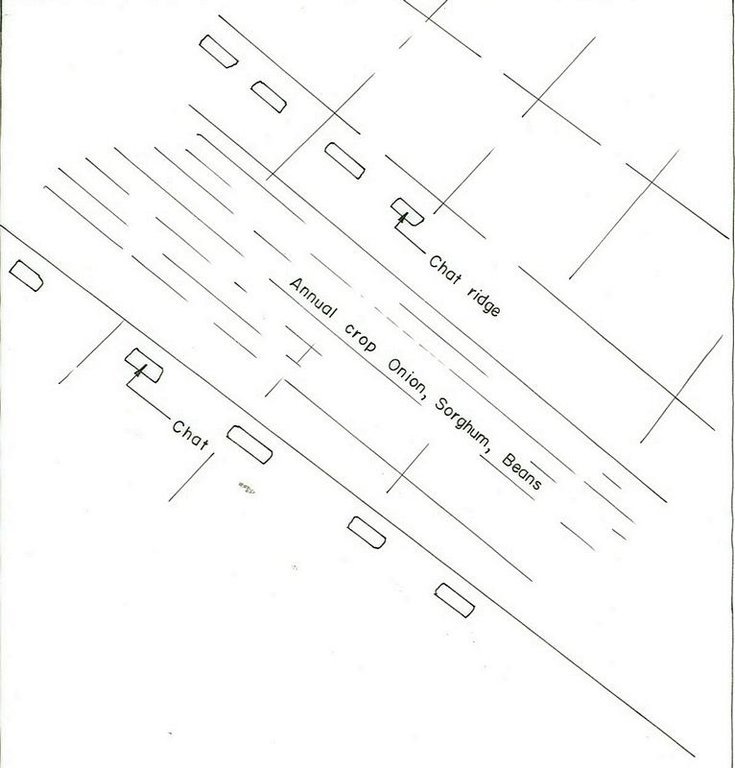Chat Ridge bund
(Ethiopia)
Chat Katara
Description
It is a mechanical conservation measure where a basin and a ridge are formed for planting chat along a contour
A contour line is maked and a pit (trench) is dug and the soil embanked on about 75x50 cm. Chat cuttings are planted on the trench. The purpose of the technology is to collect as much water as possible. The embankment protects soil from erosion. Water is collected in the trench. Households using family labour make the ridge bund. During cultivation the ridge is strengthend. Maintenance is done in case of breaks on the ridge.The technology is suitable to semi-arid with rainfall 500-700 mm/annum. Farmers grow chat as the main means of finance/capital generation. Cultivation is done twice or three times.
Location
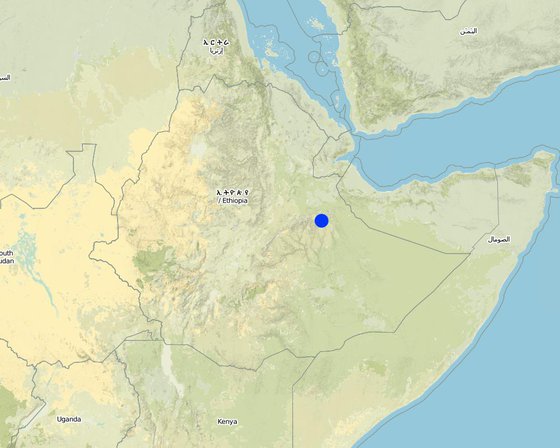
Location: Hamaressa/Bisidimo/Errer, Harari, Ethiopia
No. of Technology sites analysed:
Geo-reference of selected sites
Spread of the Technology:
In a permanently protected area?:
Date of implementation: more than 50 years ago (traditional)
Type of introduction
-
through land users' innovation
-
as part of a traditional system (> 50 years)
-
during experiments/ research
-
through projects/ external interventions
Classification of the Technology
Main purpose
-
improve production
-
reduce, prevent, restore land degradation
-
conserve ecosystem
-
protect a watershed/ downstream areas – in combination with other Technologies
-
preserve/ improve biodiversity
-
reduce risk of disasters
-
adapt to climate change/ extremes and its impacts
-
mitigate climate change and its impacts
-
create beneficial economic impact
-
create beneficial social impact
Land use
Land use mixed within the same land unit: Ja - Agro-silvopastoralism
-
Cropland
- Annual cropping: cereals - sorghum, legumes and pulses - beans, vegetables - root vegetables (carrots, onions, beet, other), chat, legume
- Tree and shrub cropping: mango, mangosteen, guava, ground nut, Cordia, Acacia
Number of growing seasons per year: 1
Is intercropping practiced? Ja
-
Grazing land
Animal type: cattle - dairy, goats
Water supply
-
rainfed
-
mixed rainfed-irrigated
-
full irrigation
Purpose related to land degradation
-
prevent land degradation
-
reduce land degradation
-
restore/ rehabilitate severely degraded land
-
adapt to land degradation
-
not applicable
Degradation addressed
-
soil erosion by water - Wt: loss of topsoil/ surface erosion
-
chemical soil deterioration - Cn: fertility decline and reduced organic matter content (not caused by erosion)
-
water degradation - Ha: aridification
SLM group
-
improved ground/ vegetation cover
-
cross-slope measure
SLM measures
Technical drawing
Technical specifications
Harari
Technical knowledge required for field staff / advisors: moderate
Technical knowledge required for land users: moderate
Main technical functions: increase of infiltration, increase / maintain water stored in soil, water harvesting / increase water supply
Secondary technical functions: control of dispersed runoff: retain / trap, reduction of slope length
Early planting
Material/ species: sorghum
Relay cropping
Material/ species: legume/sorghum
Mixed cropping / intercropping
Material/ species: beans sorghum
Contour planting / strip cropping
Material/ species: Chat, sorghum, onion
Aligned: -contour
Vegetative material: C : perennial crops
Scattered / dispersed
Vegetative material: F : fruit trees / shrubs
Trees/ shrubs species: Cordia, Acacia, Mango
Perennial crops species: Chat
Slope (which determines the spacing indicated above): 10.00%
Gradient along the rows / strips: 0.00%
Bund/ bank: level
Spacing between structures (m): 1-5
Depth of ditches/pits/dams (m): 0.3-0.4
Width of ditches/pits/dams (m): 2-3
Length of ditches/pits/dams (m): 3-4
Height of bunds/banks/others (m): 0.3
Width of bunds/banks/others (m): 0.5
Length of bunds/banks/others (m): 70-80
Construction material (earth): earth bunds
Slope (which determines the spacing indicated above): 8%
If the original slope has changed as a result of the Technology, the slope today is: 4%
Lateral gradient along the structure: 1%
Establishment and maintenance: activities, inputs and costs
Calculation of inputs and costs
- Costs are calculated:
- Currency used for cost calculation: Birr
- Exchange rate (to USD): 1 USD = 8.6 Birr
- Average wage cost of hired labour per day: 0.85
Most important factors affecting the costs
n.a.
Establishment activities
-
seed bed preparation (Timing/ frequency: Dry season)
-
preparing cutting (Timing/ frequency: rainy season)
-
cutting plantation (Timing/ frequency: rainy season)
-
cultivation (Timing/ frequency: after rain)
-
Protect from free grazing animals (Timing/ frequency: especially after crop harvest.)
Maintenance activities
-
Digging (Timing/ frequency: before rains / each cropping season)
-
Cultivation and weeding (Timing/ frequency: mid of rains / twice a year)
-
replanting of dead cuttings (Timing/ frequency: May, June /during rain)
-
cultivation (Timing/ frequency: July /during rain)
-
reridging of breaks (Timing/ frequency: September /after rain)
Natural environment
Average annual rainfall
-
< 250 mm
-
251-500 mm
-
501-750 mm
-
751-1,000 mm
-
1,001-1,500 mm
-
1,501-2,000 mm
-
2,001-3,000 mm
-
3,001-4,000 mm
-
> 4,000 mm
Agro-climatic zone
-
humid
-
sub-humid
-
semi-arid
-
arid
Specifications on climate
n.a.
Slope
-
flat (0-2%)
-
gentle (3-5%)
-
moderate (6-10%)
-
rolling (11-15%)
-
hilly (16-30%)
-
steep (31-60%)
-
very steep (>60%)
Landforms
-
plateau/plains
-
ridges
-
mountain slopes
-
hill slopes
-
footslopes
-
valley floors
Altitude
-
0-100 m a.s.l.
-
101-500 m a.s.l.
-
501-1,000 m a.s.l.
-
1,001-1,500 m a.s.l.
-
1,501-2,000 m a.s.l.
-
2,001-2,500 m a.s.l.
-
2,501-3,000 m a.s.l.
-
3,001-4,000 m a.s.l.
-
> 4,000 m a.s.l.
Technology is applied in
-
convex situations
-
concave situations
-
not relevant
Soil depth
-
very shallow (0-20 cm)
-
shallow (21-50 cm)
-
moderately deep (51-80 cm)
-
deep (81-120 cm)
-
very deep (> 120 cm)
Soil texture (topsoil)
-
coarse/ light (sandy)
-
medium (loamy, silty)
-
fine/ heavy (clay)
Soil texture (> 20 cm below surface)
-
coarse/ light (sandy)
-
medium (loamy, silty)
-
fine/ heavy (clay)
Topsoil organic matter content
-
high (>3%)
-
medium (1-3%)
-
low (<1%)
Groundwater table
-
on surface
-
< 5 m
-
5-50 m
-
> 50 m
Availability of surface water
-
excess
-
good
-
medium
-
poor/ none
Water quality (untreated)
-
good drinking water
-
poor drinking water (treatment required)
-
for agricultural use only (irrigation)
-
unusable
Is salinity a problem?
Occurrence of flooding
Characteristics of land users applying the Technology
Market orientation
-
subsistence (self-supply)
-
mixed (subsistence/ commercial)
-
commercial/ market
Off-farm income
-
less than 10% of all income
-
10-50% of all income
-
> 50% of all income
Relative level of wealth
-
very poor
-
poor
-
average
-
rich
-
very rich
Level of mechanization
-
manual work
-
animal traction
-
mechanized/ motorized
Sedentary or nomadic
-
Sedentary
-
Semi-nomadic
-
Nomadic
Individuals or groups
-
individual/ household
-
groups/ community
-
cooperative
-
employee (company, government)
Age
-
children
-
youth
-
middle-aged
-
elderly
Area used per household
-
< 0.5 ha
-
0.5-1 ha
-
1-2 ha
-
2-5 ha
-
5-15 ha
-
15-50 ha
-
50-100 ha
-
100-500 ha
-
500-1,000 ha
-
1,000-10,000 ha
-
> 10,000 ha
Scale
-
small-scale
-
medium-scale
-
large-scale
Land ownership
-
state
-
company
-
communal/ village
-
group
-
individual, not titled
-
individual, titled
Land use rights
-
open access (unorganized)
-
communal (organized)
-
leased
-
individual
Water use rights
-
open access (unorganized)
-
communal (organized)
-
leased
-
individual
Access to services and infrastructure
Cost-benefit analysis
Benefits compared with establishment costs
Short-term returns
very negative
very positive
Long-term returns
very negative
very positive
Benefits compared with maintenance costs
Short-term returns
very negative
very positive
Long-term returns
very negative
very positive
Adoption and adaptation
Percentage of land users in the area who have adopted the Technology
-
single cases/ experimental
-
1-10%
-
11-50%
-
> 50%
Of all those who have adopted the Technology, how many have done so without receiving material incentives?
-
0-10%
-
11-50%
-
51-90%
-
91-100%
Has the Technology been modified recently to adapt to changing conditions?
To which changing conditions?
-
climatic change/ extremes
-
changing markets
-
labour availability (e.g. due to migration)
Conclusions and lessons learnt
Strengths: land user's view
-
Efficient in rainwater harvesting
-
Laid out by farmers with little technical support
Strengths: compiler’s or other key resource person’s view
-
Highly flexible
How can they be sustained / enhanced? change of structures (size, position) possible
-
Material needed is locally available
How can they be sustained / enhanced? soil and stone are found everywhere
-
Low cost
How can they be sustained / enhanced? tools available at local markets
Weaknesses/ disadvantages/ risks: land user's viewhow to overcome
Weaknesses/ disadvantages/ risks: compiler’s or other key resource person’s viewhow to overcome
References
Reviewer
-
Fabian Ottiger
-
Alexandra Gavilano
Date of documentation: Mei 30, 2011
Last update: Sept. 9, 2019
Full description in the WOCAT database
Documentation was faciliated by




